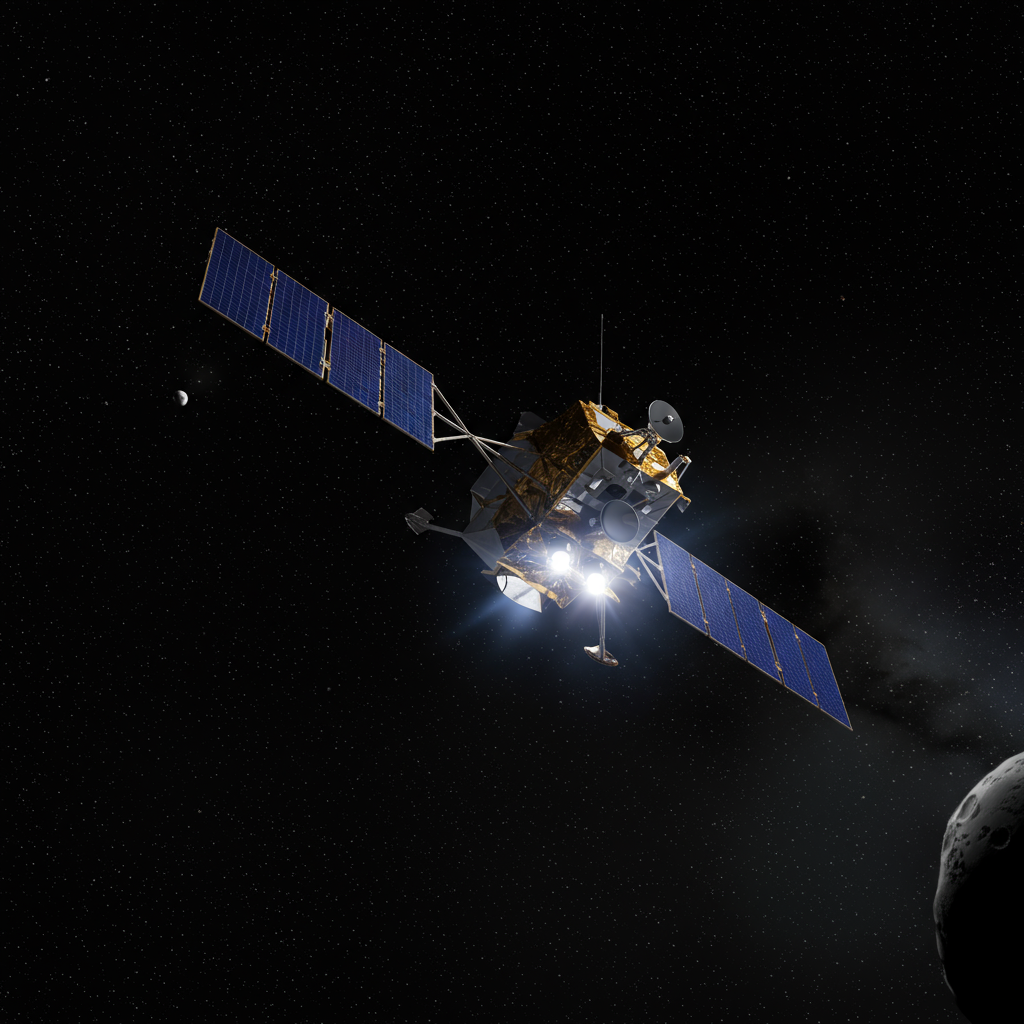NASA’s groundbreaking Psyche mission, en route to explore a unique metal-rich asteroid, has successfully overcome a recent technical challenge, switching to a backup propulsion system to stay on course for its 2029 rendezvous.
Launched in October 2023, the $1.4 billion spacecraft utilizes an advanced solar electric propulsion system. Instead of traditional chemical rockets, Psyche employs four Hall thrusters that ionize xenon gas and expel it at high speeds, generating a gentle but continuous thrust over long periods. This method is significantly more fuel-efficient, allowing the spacecraft to achieve massive changes in velocity throughout its multi-year journey across the solar system.
A Hitch in the Journey
The mission was proceeding normally until early April 2025, when the spacecraft detected an unexpected drop in pressure within the primary fuel line supplying xenon to its thrusters. The pressure fell from a nominal 36 pounds per square inch (psi) to approximately 26 psi. Sensing this anomaly, the spacecraft’s automated systems promptly powered off the thrusters.
Extensive analysis and testing by the mission team traced the issue to a likely malfunctioning valve within the primary propellant line. This valve, designed to regulate xenon flow, appeared to be causing an obstruction that restricted the fuel supply to the thrusters.
Switching to Backup and Getting Back on Track
Fortunately, electric propulsion offers significant operational flexibility. Unlike missions relying on time-critical chemical burns, Psyche could temporarily suspend thrusting operations without immediately jeopardizing its trajectory or missing key gravitational assists. Engineers determined the spacecraft could remain powered off for about six weeks without impact, requiring a resolution by mid-June 2025.
The spacecraft’s robust design includes a redundant, identical backup fuel line. In late May, ground controllers at NASA’s Jet Propulsion Laboratory (JPL) commanded Psyche to switch to this backup system. Subsequent test firings confirmed the thrusters were operating nominally using the alternate line. To mitigate the risk of a similar valve issue recurring in the backup line, the team plans to command its valve to remain permanently in an open position.
With the switch successfully implemented and tested, the Psyche spacecraft resumed full thruster operations in mid-June. The spacecraft, built by Maxar Space Systems, is scheduled to operate its electric thrusters for the equivalent of three months between now and November to maintain its precise path.
“Their thorough diagnosis and recovery, using the backup system, demonstrates the value of robust spacecraft design and exceptional teamwork,” said Bob Mase, Psyche project manager at JPL. NASA officials have also noted that built-in redundancy is specifically for managing such unexpected issues that can arise in deep space.
Target: The Metal Asteroid Psyche
The mission remains firmly on track for its next major milestone: a critical flyby of Mars in May 2026. This maneuver will use the Red Planet’s gravity to slingshot Psyche deeper into the solar system, propelling it towards the main asteroid belt located between Mars and Jupiter. The spacecraft is expected to reach this region in approximately four years.
Its ultimate destination is the asteroid 16 Psyche, a fascinating object that measures around 140 to 173 miles (226 to 280 kilometers) in diameter and has a distinctive irregular, “potato-like” shape. Psyche is particularly intriguing because it’s thought to be predominantly metallic – the first M-type (metallic) asteroid to be visited by a spacecraft. While early observations suggested it was almost entirely metal, more recent data analyzing its thermal inertia and radar reflectivity points to a composition that is likely a mix of metal (estimated 30% to 60% of its volume) and silicate rock.
Scientists hypothesize that asteroid Psyche could be the exposed nickel-iron core of an early planetesimal, one of the building blocks of rocky planets like Earth, that was shattered by collisions billions of years ago. Studying its composition, surface features (including potential craters visible in 3D models), gravity, and magnetic field will provide unprecedented insights into the formation and evolution of planetary cores and the early solar system.
Upon arrival in August 2029, the spacecraft will enter orbit around the asteroid, progressively getting closer to use its suite of instruments – including imagers, spectrometers, a magnetometer, and a radio instrument for gravity mapping – to map and analyze this unique world.
Looking Ahead
While the successful switch to the backup fuel line ensures the mission’s immediate progress, the potential cause – a faulty valve – does present a lingering concern, as the backup line uses an identical component. However, the team is actively engaged in proactive work to monitor and address any potential issues with the backup valve going forward.
Despite this recent challenge and previous delays encountered during development and pre-launch, the Psyche mission is back on its interplanetary path, showcasing the resilience of deep space engineering and keeping the scientific promise of exploring a potential metallic core in space alive for 2029.




